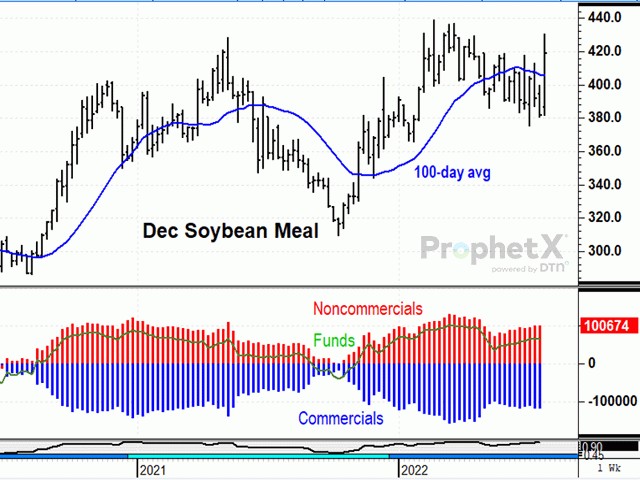Todd's Take
Classic Technical Breakout in Soybean Meal Prices Precedes Drier Weather
So often with markets, I find it pays to keep your eye on the dog that didn't bark, a valuable clue made famous by Sherlock Holmes. In this case, among new-crop grain-related contracts, the one that stayed quietly sideways in late June and early July while speculators were bailing out of corn and soybeans and wheat was December soybean meal.
Not only were specs not fleeing from meal positions like the other crops, but they were also actually slowly accumulating new positions. While many crop prices were falling by the day, soybean meal was an eerie oasis of calm in a market panicked by rising interest rates, talk of recession and occasional rain in the forecast.
Also adding to the bullish curiosity, while meal prices were mostly chopping sideways in the months of June and July, USDA's average spot price of soybean meal in Illinois was steadily rising, trading $12.00 above the August futures contract in early June, climbing to over a $60 premium by Friday, July 22.
This was no fluffy speculative move as specs aren't interested in owning cash meal. This was bullish evidence of commercial buying in soybean meal, reinforced by a steadily rising premium in the August contract over the September futures, a spread that went from $5 in early June to $32 on Friday, July 22.
Fundamentally, soybean meal does not often get a lot of attention, but it is an important part of the soybean crush. For decades, China's growing demand for soybeans was largely propelled by the need for soybean meal, the crucial feed ingredient for expanding the production of pork, poultry and aquaculture. Meal is just as important today, but since the pandemic arrived, much of the spotlight turned to soybean oil. COVID-19 restrictions in Indonesia and Malaysia in 2020 hurt palm oil production and tightened world supplies of vegetable oil, at the same time a new form of renewable diesel was being pushed in the U.S. as the new green fuel of the future.
P[L1] D[0x0] M[300x250] OOP[F] ADUNIT[] T[]
Among the two crush products, soybean oil held the spotlight of popularity until mid-June when it became more obvious that palm oil production was returning. Palm oil prices fell to their lowest level in nine months, and, in a quick 36 days, December soybean oil fell from 79.04 cents to 55.78 cents, near its lowest price this year.
Based on August futures, the combined value of meal and oil from crushing a bushel of soybeans fell to $16.62 in early July, a level that was only $2.15 above the cost of a bushel of soybeans. Thanks partly to this week's new surge in meal prices, that premium above the cost of soybeans is back up to $3.11 as of Thursday's close, July 28. Meal's newfound popularity has revived the incentive to crush soybeans and makes a strong bullish case for soybean prices, just days before the central U.S. will become a hotter, drier place for soybean crops that are about to start filling pods.
On Wednesday, July 27, the same day the Fed raised the federal funds rate target by 0.75%, August soybean meal closed up $16.50 at a new contract high of $488.90 and December soybean meal closed up $8.30 at $426.10, a new three-month high after trading in a narrow, sideways to lower pattern for five months. Thursday's (July 28) lower close for December meal is not uncommon after making a new high and does not nullify the bullishness of the situation.
As always, I can't guarantee soybean meal prices will go significantly higher or how high they will go, but I can say it is remarkable to see demand clues this bullish at a time when soybean crops are being stressed in 2022. The combination of the two can make for a powerful market dynamic.
Keep in mind soybean production was cut short by drought in South America in early 2022. Also, in the case of Argentina, the world's largest exporter of soybean meal and soybean oil, the economy has much worse inflation problems than we have in the U.S. and producers are saddled with high export taxes.
With USDA estimating a 51.5 bushels per acre yield in 2022-23 on 87.5 million harvested acres, there is not much margin to protect USDA's slim 230 million bushels of estimated ending stocks with hot weather on the way. Despite persistent echoes of COVID-19, war in Ukraine and worries about recession, world soybean demand remains strong. As I see it, Wednesday's new high in meal was an early warning flare for the tight soybean supply situation to come.
**
Comments above are for educational purposes only and are not meant as specific trade recommendations. The buying and selling of grain or grain futures or options involve substantial risk and are not suitable for everyone.
Todd Hultman can be found at Todd.Hultman@dtn.com.
Follow him on Twitter @ToddHultman1
(c) Copyright 2022 DTN, LLC. All rights reserved.




